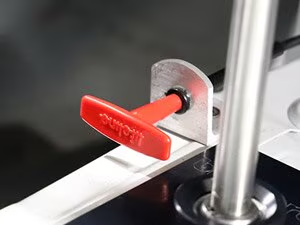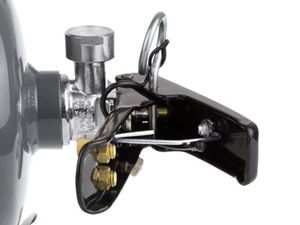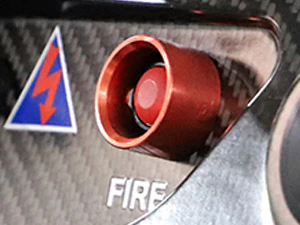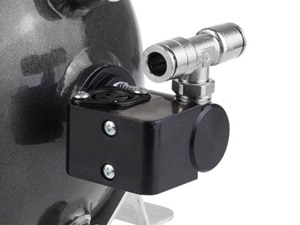|
Racing Fire Systems
Racing Fire Systems
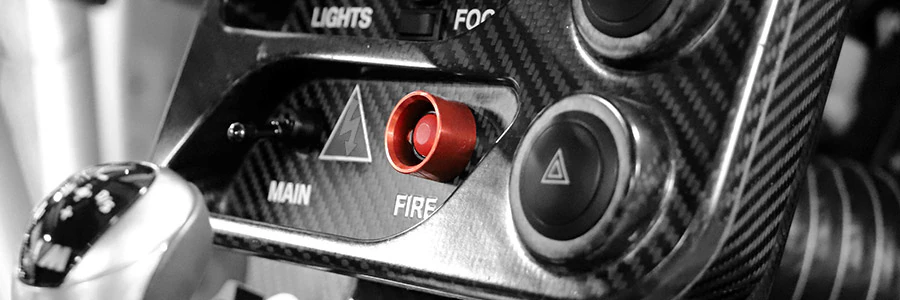
Intro
This page is very heavy on FIA-compliant systems and technology because that's where our business and BMW customers operate mostly. FIA is certainly not the only safety standard and we make notes and comparisons where relevant. If you have questions on other standards or regulations not mentioned here please contact us via email.
Nearly every racing sanctioning body on the planet puts safety above everything else and fire suppression is right there at the top of the "must-have" list. Yes, we want you to be fast on track and we'll suggest wheels, suspension, brakes, and a lot more to go fast, but we may also ask you about your safety gear - harnesses, seats, roll bar/cage, and even a fire system. As a hobby for most of us, it's not worth death or injury going without top safety gear.
And just like everyone else, we started with limited knowledge of fire systems. This page is our insight and advice on choosing a fire system for your mixed-use, dedicated track, or full race car. We've made mistakes choosing and installing the wrong equipment and we've even caught fire once or twice and we're passing on this hard-won experience free of charge. This is our real narrative, not a sales pitch (until the bottom of the page).
Don't ask yourself if you really need fire protection. The answer is yes, of course. No one plans to catch fire just like no one plans to roll over. Like other safety gear its true value reveals itself when you need it. And don't think you can get away without it just because you don't understand the requirements or the science of it. Not many people understand tire technology either yet we rush to buy the latest racing rubber. For the price of a set of slicks you can get a fire system that may literally save your butt one day.
Fire Event Lessons
Lesson #1: fire systems are in place to limit YOUR exposure to fire so you can exit the car without getting burned. The system is there to get you out of the car and not necessarily to put out the fire. Proper placement of nozzles is key to not wasting the suppressant material when it could be used to save your butt. It is not to save your car, although that may be a happy ending.
Lesson #2: there is never a guarantee that any fire system will fully extinguish a fire. Don't assume that you pull a handle and the fire goes out. Fire needs three things - oxygen, ignition source (heat), and a fuel source. If all three exist there will be flame. Fire suppressants attack one or two of those only for as long as there is suppressant available.
Lesson #3: spending more does get you more features and performance. You can get a low-cost fire system that will meet requirements. But spending more does have benefits in terms of performance, after-effects, and weight. We get into the material details below but as an example, a Novec suppressant costs more but has huge upsides compared to other materials.
Lesson #4: follow the manufacturer's instructions! Do not assume that you know more about the system - or can make improvements - than the engineers and experienced people who design them. We have seen problems or potential problems with installs where simple lack of understanding could lead to catastrophe.
Lesson #5: have and practice a fire evacuation drill with your driving gear (minimum a helmet). Most important is to be mentally prepared in the event of a fire. Pull off the track and stop the car safely, turn off the power, activate the fire system, undo your belts, release your nets, and get the Hell out of there. The requirement for professional series is 15 seconds from start to finish - can you beat that? Practice this with stress in mind - and practice some more - so it becomes automatic for you in a time of emergency.
We frown upon handhelds in a track car as the primary system, especially with a race seat and cage and especially if the bottle is mounted under the passenger seat. It's not worth risking your life to reach for, unlatch from the bracket, aim, and activate. In our view, handheld bottles are best used as a follow-up to a full fire system, either mounted inside the car as a secondary suppression tool or left in pitlane or trackside. A handheld should never be considered as a primary extinguishant. Another issue with hand-held bottles is that the suppressant material is usually dry chemical powder which has a tendency to settle and pack together over time. When it's time to pull the trigger you get a puff instead of a cloud. Hand-helds are acceptable in a street car with no obstructions in your exit path and mounted where it can be accessed from outside the car (not in the trunk). It should go without saying that returning to a burning car for an extinguisher is not safe and likely a futile effort.
Fire Systems
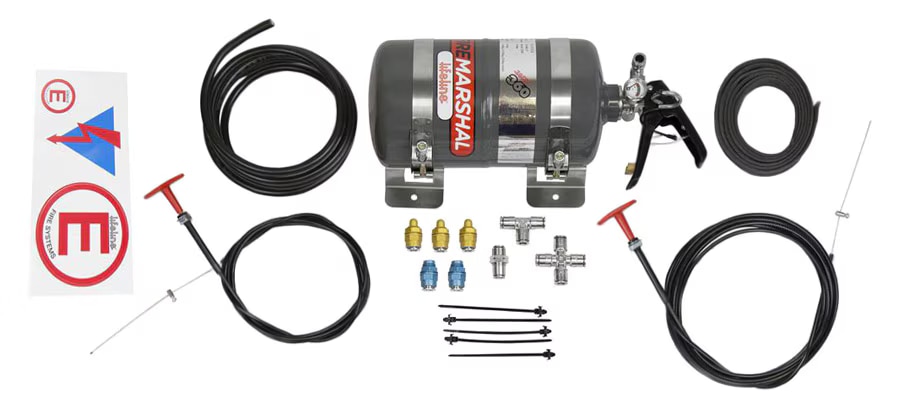
When we say "fire system" we are specifically discussing a proper, plumbed-in system with a pull-handle or push button activation and remote-mounted nozzles. A system consists of: the bottle(s), activation method, and plumbing.
Bottles are available in different size capacities, depending on the suppressant and the volume you need to cover. Don't assume that a smaller bottle is less effective as the suppressant may be superior to a larger bottle of a less-effective material. While there are often minimum requirements for race use, there's no downside to having a larger bottle, except weight. You don't want to be left saying "If I only had a little more left in the bottle...".
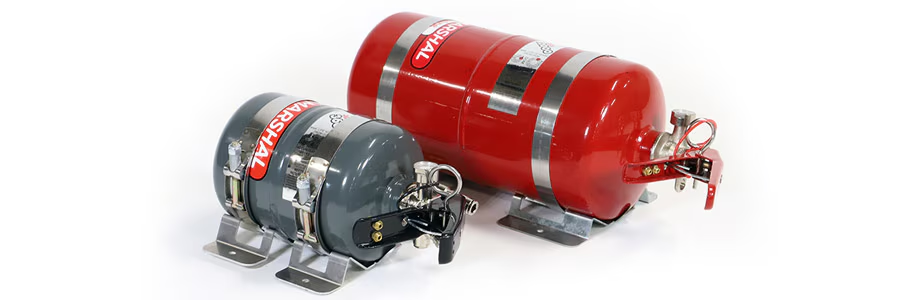
Lifeline 360 Novec 2.25kg and 2000 AFFF 4.0 liter bottles
The system is activated by either pull cables or an electric switch. The bottle is either pressurized internally or will have a separate gas charge canister (like a paintball marker). When the system is activated, a thin seal is punctured, releasing the suppressant to the lines. Officially, we don't have a BimmerWorld-preferred activation method - cable or electric. There are pros and cons to each.
Mechanical Cable
Pros: tried, true, and reliable; simple and hard to fail; harder to activate by accident
Cons: requires an extra hand motion; requires a clean and reinforced install; annual maintenance
Electric Button
Pros: easier to install; quick and seamless performance once activated; have as many buttons as you want; test feature; add an automatic detection feature
Cons: batteries requires annual replacement; chance for corrosion and failure; only a few systems have a mechanical backup; easier for accidental activation
Electrical System Batteries: Replace your batteries every year. It's cheap insurance to ensure proper activation. It's also recommended to remove the batteries in-between events. The highest-quality batteries are required - battery quality affects system performance in a big way. Lifeline tested different batteries and found some types will not trigger the system while others were flawless. The official recommended 9V battery is a type 6LR61. Inspect the battery itself to confirm 6LR61 is printed on the side - accept nothing else! Some vendors will advertise 6LR61 but supply something different.
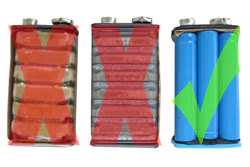
There is a test feature with the electric trigger. Follow the steps in the instructions (different systems have different steps and LED logic).
Auto-Detect Fire Systems
Some systems have the capability to auto-detect a fire based on temperature. The method for auto-detection varies but is usually based on reacting to higher and higher temperatures until the system is triggered automatically. This has been vitally important in rally and drag racing where a driver may be unable to activate the system. In some more advanced systems the fire system could be activated remotely from the pits or base camp. Auto-detect can be added as a feature on most electrical systems but not many mechanical systems yet.
Protectowire is our current method for auto-detection in an FIA-rated system (SFI has a different style of trigger). The internal wires are separated by a heat-sensitive sheath. When the sheath melts at a set temperature the wires make contact with each other which triggers the system. Click here for more on Protectowire.
Nozzles
The plumbing lines and nozzles distribute the suppressant to the zones you want coverage - with the greatest focus being on your safety. The number of nozzles depends on the suppressant material and the designed system pressure. Do not assume you can do more with more - more nozzles reduces overall system pressure and does not equal more coverage nor a more effective system! Plan your layout accordingly and follow the manufacturer's instructions exactly! For example, Novec nozzles must be pointed up because it's a heavy gas material that will settle downward. Foam will only suppress fire on the surfaces it can cover and smother. Nozzles are also designed for specific materials so don't mix them up or buy just any nozzle. Educate yourself and don't just assume the builder knew what they were doing, especially if you're renting a seat.
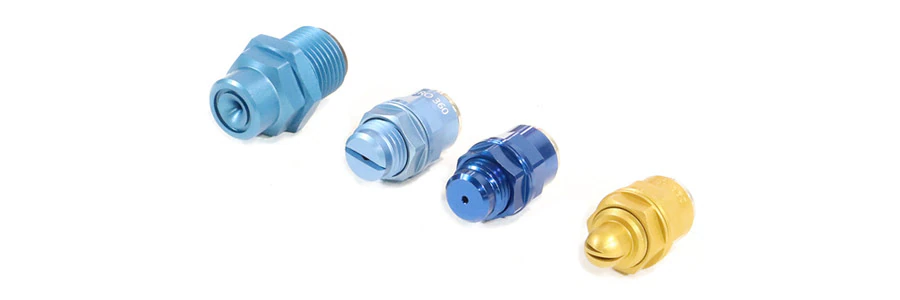
Lifeline FIA nozzle examples (2021)
Top tip: one mistake we often seen is that a nozzle is not fully seated on the line. Whether it's a push-on, crimp, or quick-release make sure you have the nozzle fully installed. If it's not then it may fail or the pressure in the whole system may be affected. Pressure loss at one nozzle will affect the whole system. Unfortunately, you won't find out until the moment of need.
Don't add nozzles or additional tubing to your fire system. More tubing equals more volume, which lowers system pressure. Same with additional nozzles. These systems are designed and engineered to release a specified volume of suppressant at a specified pressure. While adding nozzles to uncovered areas seems like a good idea you are reducing the performance of the entire system. For additional areas you should buy the right system with more coverage or an additional second system for those areas.
Bonus video: mounting a fire system bottle to your car.
Element Fire Extinguisher Stick
The Element fire extinguisher is a small handheld tube filled with Potassium Nitrate, organic oxidizer, and plasticizer resin. The Potassium oxidizes rapidly in the air and alkaline salts consume the oxygen around the fire. Once activated the powder releases uncontrolled for either 50 or 100 seconds. Point the tube and the powder at the fire source and use sweeping motions for maximum coverage. Make sure you're upwind of the fire source and close enough so that it will cover or blanket the fire and not disperse. The beauty of the Element stick is that it's light weight, easy to use, and doesn't need to be refilled or serviced. The downside is that you have to be close to the flame and windy conditions will disperse the powder. A 50 second shot lasts longer than a large 5lb handheld bottle. Element sticks work on A, B, C, and K fires so it's a proper suppressant for your car, garage, or around the house. However, like any handheld, the results will vary and it may only buy some time until a fire truck arrives. If you're lucky you can knock down the fire and prevent a flare up but it won't replace a true plumbed-in system on a race car.
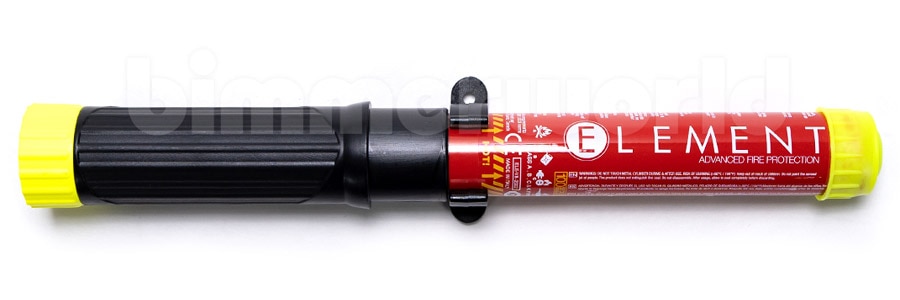
Fire-Suppression Materials
Disclaimer #1: the below descriptions are relevant to a fire suppression system permanently installed in a race car. The below information may be relevant but should not be used in the decision process for any other fire fighting application.
Disclaimer #2: You must check your rulebook to see which chemicals and regulations may be required!
Disclaimer #3: It's important to note that once any suppressant dissipates there is the potential for a flare-up or a hot spot. You either need a second shot from a handheld or wait for the emergency crews to arrive. Some systems are "two-stage" and will knock down the initial fire and also have a second suppressant that stays behind to prevent flare ups, but not every system has this. The second stage is intended for known hot spots (headers, turbos, etc) to cool the area below a re-ignition point.
What chemical do we recommend - dry chem, foam, CO2, AFFF/ABF, Halon, Coldfire, Novec, FK-5-1-12? Short answer: Novec is our current favorite but there are some fascinating new developments on the horizon. Read on for descriptions of each.
Halon (click to expand)
For years halon was The Standard for racing fire systems because of its ability to suppress multiple types of fires. It was only because its production is harmful to the ozone that halon is no longer in widespread use. It's been illegal to manufacture any Halon gas mixture since 1998. Any halon extinguisher that you find now is likely long past its service date. Halon is also considered an older fire suppressant while newer technology and chemicals are better in many areas.
CO2 (click to expand)
The CO2 suppressant works by removing oxygen from the area and is extremely cold, thereby reducing temperature and ignition source. This can be very good for fuel and oil fires as well as electrical. But as a life-saving measure, CO2 may render you unable to exit the car. CO2 is not approved for any racing use as far as we know.
Halotron (click to expand)
Halotron is an updated formula to replace Halon. It was developed mainly for aviation and airport fire fighting and has FAA and some military approval. However, it does not carry FIA or SFI approval so it's application in motorsports is either limited or not allowed at all. This is probably due to how Halotron fights a fire: it blocks the chemical reaction by displacing oxygen. Removing the oxygen in a confined space (such as a racecar cockpit) is a recipe for disaster. Indeed, according to the MSDS, "may cause suffocation as oxygen is displaced and [space] should not be entered without a self-contained breathing apparatus". It may also cause damage to liver and the central nervous system through inhalation or prolonged or repeated exposure.
ABC (dry chemical, powder) (click to expand)
This gets its name from the 3 classes of fire that it's designed to suppress - A for combustible material, B for flammable liquids, and C for electrical fires. The suppressant is known as a "dry chemical", "dry chem", or "powder" and is usually made up of monoammonium phosphate and ammonium sulfate. Note: "Dry Powder" also refers to a different suppressant material for Class D fires but is most often referenced for ABC dry chemical suppressants. The dry chemical isolates the oxygen while separating the fuel source. As a powder the dry chemical is easy to disperse and coat surfaces, even hard to reach areas. However, the dry chemical is corrosive to metal and electrical items. And it can be spread everywhere, making clean-up very difficult. Powder will also settle and compact together over time, helped by vibration which is a constant in vehicles. Packed and hardened powder will not disperse through the system! We've seen a puff where there should have been a dense cloud! Most commercially-available handheld extinguishers will use ABC because of its good all-around performance and low cost but we don't recommend this for any vehicle use.
Monnex Powder (click to expand)
Monnex is the next generation of dry powder and surpasses ABC powder in many ways. When exposed to heat, Monnex breaks down into smaller particles which increases total surface area of the material and distributes it more evenly. This does a better job of smothering flames and separating oxygen and heat, preventing fire from occurring. In testing, Monnex knocked down a fire in significantly less time than ABC powder. Unlike ABC, Monnex is non-corrosive and wipes away like a fine powder. Monnex is classed for B and C flammable materials so it works very well on gas, liquids, and electronics. Monnex works great on its own but can also be combined with other suppressants to act as a "dual-agent" system.
AFFF/ABF (Aqueous Film Forming Foam or foam for short) (click to expand)
When people say "foam" they are referring to AFFF or ABF. The foam suppressant is a water-based liquid that coats surfaces, removing the ignition source and oxygen. The foam is two-dimensional and can only suppress what it can cover so the position of the nozzle is critical. There are typically more nozzles in a foam system than powder or gas so the installation will be more extensive and complex. Once the fire is smothered the foam stays behind to prevent flare-ups. It works especially well on fuel and oil fires but not good at all for an electrical fire because the water is conductive. Clean-up is easy but the chemical can be corrosive if left behind. Because it's water based it's susceptible to freezing but some products contain an antifreeze component. If this is a concern check for the freeze point. AFFF has often been used in forest fires but is being phased out because of the contamination left behind. Cold Fire is a similar material but is biodegradable and may become the dominant fire suppressant material in the future. The minimum requirement for an FIA fire system is an AFFF or ABF suppressant.
Cold Fire (click to expand)
Similar but superior to AFFF but is environmentally friendly. It's non-toxic, non-corrosive, plant-based, and biodegradable. Like the name says it works by reducing the heat and penetrating and breaking down the fuel source. As a liquid it works well with fuel and oil but will not be effective for an electrical fire. Sometimes it's mixed with a small amount of dry chem to make it thicker and cling to surfaces for longer.
Novec, 1230, FK-5-1-12 (click to expand)
Our favorite material. Novec works by removing (absorbing) heat and blocking oxygen. It starts as a liquid but is atomized into a heavy gas as it exits the nozzle and the fog travels to all surfaces. It will get into crevices and under surfaces unlike powder or foam that can only coat like a blanket. The vapor alone is enough to suppress flame as it expands. This means you can do more with less - it does not require as much material so your bottle can be smaller (less weight). Novec is non-conductive so it's not harmful to electronics and is non-corrosive. It's not harmful to humans except in prolonged high levels where it can cause a heart arrhythmia. Clean-up is super easy as the material evaporates and there is no residue left behind. The beauty of Novec is that it knocks down the fire, allows you to exit, is non-toxic, and does not ruin your electronics.
Is Novec being discontinued? Novec is a brand name owned by 3M, who also secured a patent for the gas. The patent expired and 3M decided not continue production of Novec due to evolving environmental laws. The gas itself is still available, just under different brand names (FK-5-1-12 for example). We're proud to continue sourcing Novec alternatives from European suppliers until a better fire suppression gas becomes available.
One of our favorite anecdotes on Novec is the story of a pro team that had a fire while fueling (which is actually common but is usually benign) that was extinguished by a 3rd party using a foam system. The liquid foam destroyed all of the car's electronics and they were forced to retire. A similar incident happened with a Novec system and the material dissipated, leaving no damage behind. The team installed a spare bottle and they were able to continue with their race.
Fire Classifications
While not really relevant to auto racing suppressants there are official classification types for fires. This is especially important when purchasing a fire extinguisher for auto, RV, garage, or home use. Different types of fires and combustibles require different types of suppressant to efficiently knock down the fire. Look on the fire bottle for the type.
Class A: solid combustible material such as wood and paper, fabrics, trash
Class B: liquids such as gasoline, oil, alcohol, ether, paint
Class C: electrical or sparking (the US uses "C")
Class D: metallic material such as magnesium, titanium, sodium
Class E: electrical or sparking (the UK/EU uses "E-lectrical")
Class F: kitchen grease or cooking oil (the UK uses "F")
Class K: kitchen grease or cooking oil (the US uses "K-itchen")
Ready! Aim! Fire!
Fire safety systems in action.
Dual-agent Novec and AFFF system:
Novec vs Water Sprinkler in an office environment (not race cars but this was pretty impressive):
Check out this amazing video of a dual-agent system (Cold Fire and Monnex) in action (we sped up to the good part):
Monnex vs BC Powder test:
FIA and SFI
Your sanctioning body will almost always follow either FIA or SFI standards for a fire system. BimmerWorld prefers to recommend FIA systems. Sanctioning bodies usually prefer one over the other and sometimes both. They both have a huge emphasis on safety but will have different standards and requirements so you must pay attention to what your rulebook calls for. Most of the differences between FIA and SFI are due to how the testing is carried out and we consider the FIA tests more difficult and set to a higher standard. SFI systems typically call for more capacity and automatic activation options that are specific to their racers - drag racing, circle track, or dirt track. Both require a two year inspection of the bottle and both prohibit dry-chem powder, CO2, or Halon material. For an FIA certification it must be either foam or Novec-based (the dual-agent Monnex/ColdFire being an exception). A major revision for FIA standards was put into place for 2018 so make sure you check if an older system is still compliant.
Rallying is the driving force in FIA standards because so much of the racing is done in remote areas far away from professional emergency response. The challenge to knock down a fire and give the driver and co-driver a means to survive is much tougher than on a enclosed race track and the systems need to be capable of overcoming that challenge. Rally cars are required to have a large plumbed-in system and one or more hand-held extinguishers. Because rallying is a much more demanding set of challenges it often forms the basis for FIA approvals.
Service & Refills
Most sanctioning bodies require the system be serviced every two years and if you expect the system to work when you need it, this is a proper service interval - don't skimp here! And don't wait until the last minute!
There is a difference between a Service and a Refill. The refill is exactly what it sounds like - adding new material (or harvested Novec) into the bottle to meet its required volume. Refills are required when the system has been discharged and the service and certification are included. A service is when the full bottle is sent back after a two year period without being discharged and without wear and tear. A routine service includes emptying the bottle, inspecting for damaged components, rust and corrosion, removal of any deposits or obstructions, pressurizing the bottle and nozzle, and refilling with the correct suppressant. Mechanical triggers are tested while electrical triggers get replaced. Any other wear and tear items are an additional expense. Service must be done by an authorized dealer. The bottle is tagged with a sticker or tag so safety inspectors get an easy confirmation of a valid service. BimmerWorld is an authorized Lifeline service center (for FIA and SFI certifications, not for DOT).
The powder and foam suppressants get a complete replacement as they can settle and harden with age and vibration. We don't re-use powder or foam. Novec, however, can be recycled and re-used. Servicing a Novec system is roughly the same price as a foam system because the Novec gas can be re-used. However, filling a Novec system is more expensive because it needs a complete, new gas charge. While superior in many ways the Novec gas itself is not cheap.
There are limitations to what can be serviced. Check the manufacturer or service sticker on the bottle to determine its age.
- Bottles that are 6 years past the label service date can no longer be charged
- Bottles that are over 10 years old cannot be serviced.
Keep up with the regular 2-year service interval and you should have no problem getting the maximum life from the bottle. Ignoring service will shorten that lifespan and will require additional costs to get a system back into proper functioning order.
Great! Sign me up!
BimmerWorld has been in the race car business for over 25 years, including selling and servicing fire systems for a good chunk of that time. We have been a dealer for Lifeline Fire Systems since 2015. What impressed us the most is how involved Lifeline is with FIA regulations for fire safety. Lifeline engineers observed bad safety practices and habits at many race events and worked with the FIA to come up with the new, more stringent FIA regulations (8865-2015). The Lifeline products are so ahead of the curve they are standard equipment in many factory race cars, including factory BMW racecars like the M2 CS Racing, M4 GT4, and M4 GT3 cars. We have such respect for the efforts that Lifeline puts into safety that it's the only fire system we want to sell and use.
Lifeline Buyer's Guide
Lifeline is based in the UK and has a close working relationship with the FIA and SFI to promote better fire safety products. They also push to evolve safety to new technology and materials. By adopting FIA standards as a minimum we can be sure Lifeline products are the very latest and safest. They have adopted AFFF/ABF and Novec as the basis for most of their systems but will also use other suppressants such as Monnex or Cold Fire to build "dual-agent" systems. Lifeline bottles use the Metric system for capacity and may appear on the small side but their advanced suppressant means they can do more with less.
Q: What suppressant should I use?
A: First you have to consult your rulebook. Barring that the answer is how much do you want to spend. Since all Lifeline products that we sell are FIA-approved you're getting a highly-capable system with excellent performance. Their products are like a "Better-Best" approach, leaving out the "Good" in favor of materials and technology that is simply better. Foam and Cold Fire systems are Better but Novec is Best. Novec material itself is expensive so the initial fill and any refills will cost more. But if you have significant amounts of pricey electronics inside your car then the price delta is moot - the higher priced Novec will not ruin your equipment like foam and water-based materials will.
Q: What happened to AFFF foam?
A: AFFF was great for a fire extinguisher system and was even used at forest fires. Unfortunately it was harmful to the environment because it contained "forever chemicals". AFFF has been phased out and replaced by ABF. The ABF formula is better at fighting oil and grease fires so less material is required. This means a smaller bottle so weight is reduced even further! Systems that previously used AFFF cannot easily adapt the ABF bottle without modification to the layout and tubing. It would be better to start with an all-new system.
Q: What size system should I get?
A: Our experience is limited to BMW cars but that should transfer over to other cars of similar interior volume. We use the Novec systems with the 2.25kg bottle (4.95lbs). There's nothing stopping you from moving up to the 3.0kg bottle either except too much Novec in a confined space may cause a heart arrhythmia. There is a 1.5kg bottle that is intended only for smaller formula-style race cars. The foam systems are only available in liter sizes which is bulkier and heavier than the Novec.
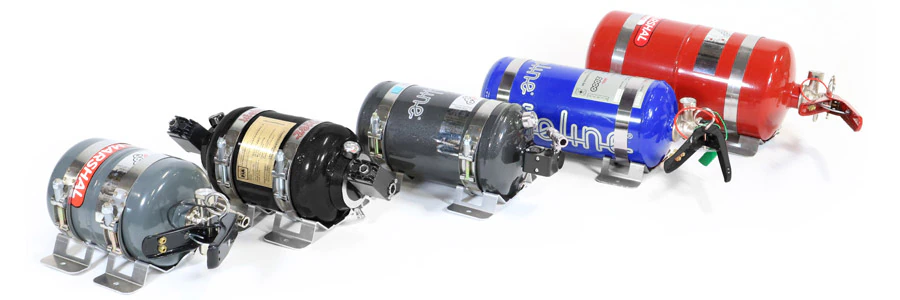
Lifeline bottles - Novec 2.25kg, Cold Fire/Monnex 1.0kg, Novec 3.0kg, ABF 2.25-liter, and AFFF 4.0-liter
Q: What are the differences in Lifeline systems?
A: Lifeline uses only foam, Novec, or Monnex powder in their systems.
Zero 2020 is their ABF foam system The 2020 replaces the previous 2000 AFFF version. Both 2020 and 2000 meet FIA Tech List 16 but not the latest 8865-2015.
Zero 2000 Club is for racing series that do not require any fire system but is a better option than a hand-held or no system at all. This is a small 2.25-liter AFFF foam system. BimmerWorld does not sell the Club system since it is not FIA approved.
Zero 360 is for Novec. It passes FIA Tech List 16 regulations but has not been submitted for the newer 8865-2015 standard.
Zero 3620 is a dual-agent system using foam and Novec gas. It is FIA 8865-2015 approved. The newest version is the "Fire Marshal" system featuring both suppressants housed in a single bottle, replacing the previous two-bottle layout. Foam is sprayed into the engine compartment and Novec is dispersed into the cockpit.
Zero 275 is a newer development as a dual-agent system using Cold Fire and a small concentration of Monnex dry chemical. It's FIA 8865-2015 approved and is the lightest and most compact Lifeline system. The suppressant capacity may be small (1.0kg) but the volume it covers is huge - up to 4m3 (141cu ft)! The 275 packs the most features and technology so it's the most expensive but is standard equipment in many factory race cars (including BMW).
Q: What about a handheld fire extinguisher?
A: Any handheld bottle or fire stick is considered a supplement to a full plumbed-in fire system. We would never recommend a handheld as the sole fire suppression in any track or race vehicle. The handheld buys you time until a real fire truck or additional handheld bottles, from pit lane or corner workers, respond. However, a handheld would not be a bad idea in a street car where it can take many minutes for a fire truck to arrive. Having a ABC suppressant buys you some time until help arrives. Ideally the handheld would be mounted near the driver's side door opening and not under the passenger seat. Reaching over the center console and under the passenger seat to unlatch a handheld bottle while the car is on fire is burning up precious seconds. Also consider that typical handheld bottles are filled with powder, which will settle and compact over time. When it's time to pull the trigger you get a puff instead of a cloud.
Q: What is a Remote Charge system?
A: All fire systems require a propellant to force the suppressant material through the lines. In a traditional system the suppressant is poured into the bottle then sealed. Then the tank is pressurized with the gas propellant (usually Nitrogen). Lifeline has several Remote Charge designs that place the propellant outside the bottle. This allows the bottle to be smaller and for the suppressant to be "pure" as none of the propellant gets mixed in. Remote Charge systems react faster and discharge the suppressant quicker.
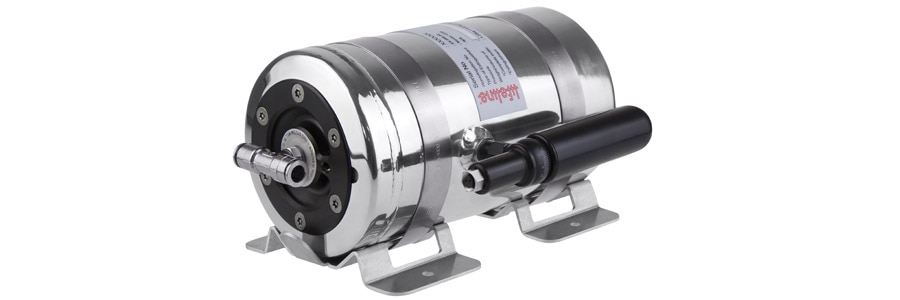
Remote Charge canister mounted outside the bottle
Q: What is the Lifeline "Fire Marshal" system and compared to others?
Q: Fire Marshal is Lifeline's label for a system with a mechanical actuator and a steel bottle (the least expensive combination). All other systems are electric.
Does It All Matter?
The video below is a very scary and teachable moment from the start of our race week at the 2016 Sebring 150 with IMSA/CTSC. A high-pressure fuel injector failed, spraying a red-hot turbo with fuel and igniting the engine bay. Our Lifeline Novec fire system squashed the fire, even as it was being fed fuel while heading to our pit stall, which was our best chance to ensure we limited our damage. With well-calculated decision making and a fast crew, we turned what could have been a dangerous disaster into a solid race weekend.
Also note that this was a test day, so stopping in another team’s box with no warning and expecting them to be prepared when there is no refueling on pit lane would be more than optimistic. Our team was ready with multiple bottles because the driver was on the radio talking through the situation with the crew.
Driver and BimmerWorld President, James Clay: “This is the first time I have been in a car fire, and I can tell you it is HOT! Instead of panicking, I made a few decisions in a row that weren’t necessarily standard process, but all led to bringing both myself and our car in safely.
If I hadn’t drilled in the standard process and contingency options in advance, I would have had much bigger problems. Fire is scary, and it would be tremendous if how smoothly this can go with the proper equipment, installation, and processes is as widely discussed as the horror of what happens when it doesn’t go right, or the equipment is sub-par, or not installed or used correctly. You always hear about the guy that died on the track – maybe we need to hear more about the guy that came to a controlled stop in his pit box with a fuel fire raging without physical harm to any person, and minimal equipment damage. In a huge number of situations, this COULD be the reality with a little preparation.”
Check out our Lifeline racing fire systems below.
| Sort by Name | Sort by Price |


